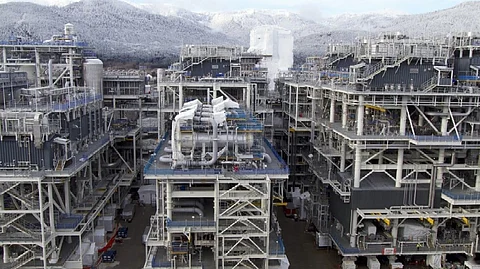

The joke may soon be on US gas consumers who have relied on Canada — especially Alberta and British Columbia — as a cheap source of natural gas to heat their homes and power their industries at bargain basement prices.
That’s because the massive LNG Canada project on BC’s West Coast will officially begin taking gas to initiate a complex production start-up on April 1.
The tanker Maran Gas Roxana will arrive in Kitimat from Australia, to cool down the LNG Canada plant — an essential final step before production of supercooled natural gas begins.
Canada is officially stepping out onto the global liquefied natural gas (LNG) stage with the $40 billion project that marks the largest private infrastructure investment in the country’s history.
Despite past skepticism from federal officials — including former Prime Minister Justin Trudeau’s assertion that there was “no business case” for LNG exports — LNG Canada is set to deliver structural changes to North America’s energy market, challenging the US’ long-held dominance.
And it’s just in time, given that US president Donald Trump is set to begin imposing ‘reciprocal’ tariffs on Canadian industry, including 10% on energy, starting on April 2.
The facility, backed by global energy giant Shell along with partners Petronas, PetroChina, Mitsubishi Corporation and Kogas, will initially produce 14 million metric tons per annum (MTPA), with potential expansion to 28 MTPA.
At the heart of LNG Canada is Shell, the Anglo-Dutch supermajor and the project’s largest financial backer.
Not by coincidence, company officials were in New York on Tuesday to outline plans to grow LNG sales 5% annually through 2030 as part of its broader strategy to solidify its position in the global gas market.
‘‘We want to become the world’s leading integrated gas and LNG business and the most customer-focused energy marketer and trader," CEO Wael Sawan told investors.
The company has long viewed LNG as a key pillar of its transition strategy, positioning it as a bridge fuel that offers lower emissions than coal and oil while ensuring energy security for key allies in Asia and Europe — a striking contrast to previous federal skepticism in Ottawa.
Former Prime Minister Justin Trudeau infamously stated that there was “no business case” for Canadian LNG exports to reduce greenhouse gas emissions or provide energy security to allies under the Paris Accord. Yet, Shell and its partners have moved forward, betting big on Canada’s potential to become a top-tier LNG exporter.
Longer term, LNG Canada’s entry into the market is expected to divert a significant portion of its natural gas exports away from the US, which has long been the country’s only major customer.
Canadian gas exports to the US hit 8.6 billion cubic feet per day (bcf/d) in 2024, up from 8.0 bcf/d the previous year, according to the US Energy Information Administration (EIA). However, traders anticipate a decline in cross-border shipments as homegrown producers gain direct access to lucrative overseas markets.
The timing of Canada’s LNG emergence is geopolitically significant. That’s because the former Biden administration last year paused approvals for new US LNG projects, citing climate concerns. Now Trump is playing catch-up with plans to ramp up production and exports from Alaska.
Despite these uncertainties, Alberta remains steadfast as a major hub for North American energy. The region, which produced 10.9 bcf/d in 2023 — accounts for 61% of Canada’s gas output and is poised to benefit the most from LNG Canada’s operations.
Beyond LNG, Alberta is attracting significant investment in downstream energy and technology as it moves up the gas value chain.
The province has secured over $34 billion in new investment in the last four years, creating more than 35,000 jobs. Among these projects is Dow Chemical’s $6.5 billion Path2Zero ethylene cracker complex and a massive hydrogen facility by Air Products and Chemicals Inc., which will integrate carbon capture technology.
Additionally, Alberta is emerging as a prime destination for data centres, with Amazon Web Services (AWS) leading a $3 billion investment in Calgary — its first outside the US.
Abundant natural gas, favorable weather for cooling and streamlined regulatory environment are driving a surge in hyperscale data centre developments, reinforcing Alberta’s reputation as a hub for both energy and digital infrastructure.
The government of Alberta has set an ambitious target of attracting $100 billion in data investments by 2030, encouraging developers to bring their own power.
What it means is the stars are starting to align, and not even Trump can stop it. Not if he wants to secure American energy ‘dominance’.
Analysts say Canada could — and should — become a reliable ‘back filler’ as the US expands its Gulf Coast export capacity. That means Canada could ‘fortress’ the North American continent, but only at The Donald's choosing.
Or he could divert his own higher cost molecules and drive up prices for American consumers, which he seems perfectly content to do.
But for Canadians? That facade is set to crumble. In the nick of time.
